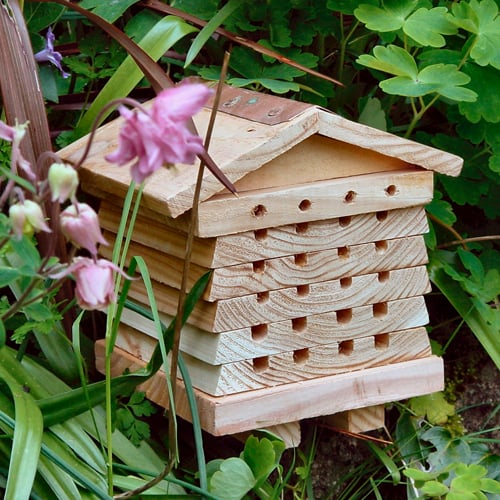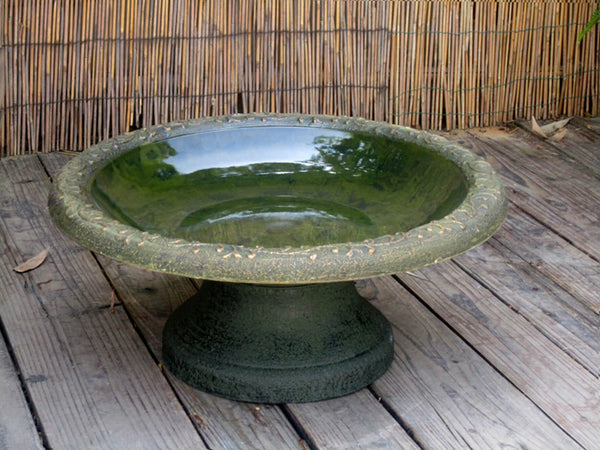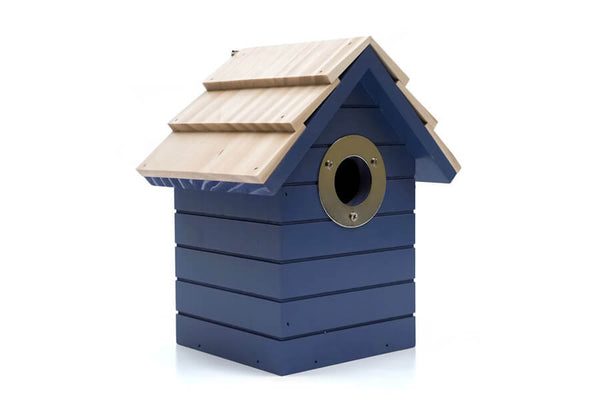Create Your Own Wildlife-Friendly Garden
A wildlife-friendly garden is a truly wonderful thing! It can bring such a huge amount of biodiversity to your neighbourhood, and allow you and your family to have a hand in the world that is living right on your doorstep.
People adore gardening - there's no secret about that. The impressive thing about gardening in a wildlife-focussed way, though, is that you can be entirely sure of creating habitats for species that certainly need them.

Whether your garden is at the dead centre of a city, or it's a fenced-off patch of grass among acres of fields, you're sure to help some form of wildlife if you garden with them in mind.
Wildlife Garden
A good way to start this article off is to quickly define what we mean when we speak about wildlife gardening. A wildlife garden, in realistic sense, is a garden that's designed and built around wildlife. This might sound a little obvious but just stay with us.

Your personal approach
By this, we mean that every element of the garden is approached with that sense of adoration and acceptance for wildlife. This means that instead of simply picking which flowers at the nursery look the prettiest, you may also consider which flowers may be better for pollinators, or may encourage insects that are ideal prey for birds or hedgehogs.

Therefore, we would say that a wildlife garden is one that is made with a different philosophy from a regular garden - every element of a wildlife garden is carefully considered, so that wildlife is safe, happy, and cared for.
Garden Birds
There is a wide range of birds throughout the UK that will love to spend time in a garden that's been specifically made for wildlife near to you. Some of the best examples are birds that you, more than likely, are already particularly familiar with.
For example, robins and bluebirds are typically among the first garden birds to come to a newly habitable space, finding a little solace from stiff breezes among tall fence panels.

Small birds like those benefit from outdoor space since they can need a little respite, though, they might not truly want to go inside, if they have the choice.
Nesting sites
Nesting sites are typically plentiful in the eaves of outdoor structures, or even simple fruit trees. To make your garden a little better for a garden bird, a great first step is to introduce more and more of the food they might like - try mealworms and seeds as a general food offering. When specific species start to arrive, you can tailor your buffet to their desires.

Attract Bees
Having bees in your garden is a wonderful thing - from their ability to cross-pollinate throughout all of your crops to their bumbling, sweet, and encouraging presence, they're a sweet friend to most gardeners. Thankfully, you don't need to buy an apiary to start things up with regard to bees - simply planting some nectar-rich plants can be a great first step.

Nectar Rich Plants
Nectar-dense plants are great not only for bees, but also for other pollinating insects, such as butterflies. A great example of a native species to the UK that are packed with nectar is lavender!
Lavender is a beautiful flower, in flavour, scent, and appearance, and can be just as enticing to pollinators as it is to humans. For a nectar-rich plant, lavender is a great stalwart.

No grass? That's fine too!
Grass is something of a trend, in terms of gardens. Excuse our mini-rant, but: it was popularised by French aristocracy as a display of wealth, and simply never went away. In our modern world, there's really little sense in having a bountiful crop of grass - especially for native wildlife.

Reduce your grass
Allowing things to go back to nature just a little can be a great way to reduce the grass in your outdoor space, leading to the growth of clover, moss, and other greenery. This increase in biodiversity will be better for the animals and insects near you, not to mention the bacteria in the soil.
These things are all connected, and allowing for greater surface-level diversity (by forgetting your loyalty to grass) is a great way to build from the ground up.

Allow a little mess
A little mess and dirt in your garden is a good thing. In fact, it's healthy for the plants and animals that live near you to have a world that's a little cross-contaminated.
Avoid scrubbing at the patio tiles in your garden, and instead allow a few patches of moss to grow - it will do no harm to the stone, and it will provide food for insects and, in turn, birds.

The active issue
Actively maintaining a neat, clean, and tidy garden can actually be a bad thing. The reason for this is that you're likely to opt for any of the external cleaning chemicals that are on the market in an attempt to scour any muck from paving slabs.
These chemicals can leach into the ground, leading to a poor overall biome in your garden.

Bee-friendly plants for your garden
There is a wide range of different bee-friendly plants for your garden and, happily, the vast majority of them are ones that will be friendly to you, too. Lavender is a great example to briefly mention, and it's one that we've spoken about before - the purple flowers and sweet aroma are a dead giveaway: bees can't get enough!
Non-lavender options

In the same vein, herbs like chives and marjoram have much the same effect as lavender. Their natural, soothing aroma and gentle purple flowers can attract a wealth of bees, leading to a well-balanced and delicately impressive range of wildlife in your garden.
Natural garden pest control
Natural pest control can take two forms - plants and home remedies.
Plants - more useful than you might think
The plant method is our favoured option since it's one that leans into the idea of different elements naturally balancing off one another, leading to the final result being something that you've created. For example, slugs dislike the aroma of rosemary, and flies dislike the aroma of marigolds and basil.

Pots of handy solutions
This means that, as natural pest control methods, you could plant a number of pots with these three plants. These elements balance off one another to dissuade the most insects possible, leading to a powerful punch of pest control!
Home remedies are a little different than plants, but they do work, all the same. The most effective remedies are generally options that opt for non-toxic chemicals that will not damage the soil in your garden, or the water in your water butt or garden pond.

Is this still a wildlife-friendly garden?
These chemical solutions can have a place in a wildlife garden, as they allow you to make a garden that's accepting of some wildlife while dissuading others.
An easy option is to dilute some lemon-scented dish soap in hot water and spray that on hard surfaces, and on plants. The limonene (a lemon-derived chemical that creates the aroma of lemon) dissuades a range of pests, from house cats to aphids.
On top of this, dish soap is non-toxic, and won't damage any of your plants, or any furry friends that might visit your wildlife garden.
Making a bee hotel

A bee hotel is something that you may have seen in a local garden center, without really knowing what it is. The concept is simple - it's typically multiple wooden tubes stacked within a small wooden frame. The tubes are just large enough for a bee to crawl inside, and take refuge within.
The idea

You can make a bee hotel by trimming bamboo gardening canes down to size and using some non-toxic glue to fasten them together in a large clump.
Bees, typically mason bees, that are away from the hive on their own or in small groups, will spot the small holes if it starts to rain while they're flying. Since they can't fly in the rain, they will head into the bee hotel, waiting for a few hours, before flying back to their hive.

Why attract wildlife to your garden?
There are so many reasons why you might like to attract wildlife to your garden, but the main reason that comes to mind is really very simple: it's something that will allow you to get a little more in touch with the world around you.
All through your life, you may have seen the pigeons landing in your garden as frustrating pests and the spiders that adore your shed as annoying hassles.
The bigger picture
We understand those frustrations, but a wildlife garden can help you to view those creatures as part of a larger, interconnected web of wildlife, allowing you to appreciate every element a little more.

How to get started gardening for wildlife
The best way to get started gardening for wildlife is generally to start gardening for birds. Birds have spectacular vision, so they'll easily be able to spot if you put up a bird table, or scatter some bird seeds on the ground.
Before long, they'll flock to your garden looking for a meal, and the natural habitats that you can provide will be happy homes for them.
Bird boxes
Aside from starting to provide food for birds, you can start to offer nesting sites. This can include bird boxes, which are typically quite affordable and don't cost an awful lot of money to purchase for your home. They're a great way to invite wildlife into your garden.
How to build a hedgehog house
A hedgehog house is a sweet, small feature of many wildlife gardens. Thankfully, it typically doesn't take too much work to construct, especially if you've already got a little experience with carpentry.
Start cutting five wooden panels - one for each wall, and one for the roof of the house. The front and back walls can be rectangular, but the side walls should have sloping top edges - this allows for a sloped roof, leaving to rainwater flowing away.

Once you've got the panels, it's simply a matter of fastening them together. The easiest way to do this is to use small tacks or nails.
These can be bought cheaply, and used to create the shape of the house you're building. Finish the house by drilling a 'door' into the front wall, creating a small hole that a hedgehog can easily walk through.
Once you've finished with it, move the hedgehog house to a sheltered location, and offer wet cat food nearby. The hedgehog will certainly smell the food and come in search of it.
An easy step to encourage biodiversity
We touched on this earlier, but a great way to encourage biodiversity easily is to step away from your lawn.
Stop mowing for a month or two, and allow the grass to grow tall: tall blades can be used as shelter by small mammals and can be an insect hunting ground for those same elements of garden wildlife. Additional Garden wildlife products such as bee hotels can also be a great addition!
To turn the dial up a little and garden wildlife friendly a little more, you could consider replacing the grass in your garden completely and opting for a creeping plant to give you the same grounds cover, with less maintenance and a more wildlife-friendly outlook.

Alternatives to grass
A wonderful, almost universal, plant that is used as an alternative to grass is red creeping thyme. It only grows to be a few centimeters tall at most and doesn't need much in the way of water or fertile soil. Adding to topsoil with scraps from the base of your compost heap will give the plant a great headstart, and a little water now and then will maintain it well.
Hedgehog highways
A hedgehog highway is a great partner to a hedgehog house - it's a series of small holes through your fence, and then your neighbour's fence, then their neighbour's fence, etc. The concept is simple: you can create an easy way for hedgehogs to troop between gardens, root out insect pests, and live a fairly relaxed life.

Co-operate with your neighbours
Planting options which can complement what's in your neighbours garden can be a great option, allowing for increased biodiversity in a small location.
A great example of this could be the companion plants of crop-yielding plants and scented flowers in neighbouring gardens. The aroma of the flowers will deter pests, while there will still be plenty of space for crop-yielding plants in the other garden.
How can a small garden be used?
A great choice, in a small garden, is to attract pollinators with scented and beautiful flowers in vertical planters or otherwise in pots.
For example, you could simply plant a range of marigolds in pots, or you could be a little creative - planting herbs and spices in repurposed guttering to create a complex and wonderfully interesting feature for your small garden.
Pollinator-friendly plants
There is a range of pollinator-friendly plants out there, the vast majority of which can be gathered from a garden centre near you. For now, we're going to mention two of our favourite tidbits on this front.
Purple flowers
Purple flowers seem to have a strange correlation with pollinators. Whether they're sprouting next to a picturesque garden pond, or within a smelly compost heap, purple flowers seem to emit an aura to pollinators, urging the little creatures closer.
This is likely something to do with the unique eyesight of insects, but it's a worthwhile tidbit to bear in mind - if you're picking different flowers, purple options may be for the best.
A centrepiece tree
A non-fruiting tree produces a lot of pollen during the course of an average spring, while a fruiting tree produces little, due to the nature of how fruit is fertilised and grows. This means that no matter what type of tree you have, pollinators are likely to be zipping back and forth from it.
They're liable to be visiting to either gather or dispense pollen, which is one of their favourite things to do. Trees can be great for garden wildlife since they will easily attract a range of pollinators.
What is a wildlife-friendly garden?

A wildlife-friendly garden is, at the heart of it, a lot simpler than you might think. Wildlife-friendly gardening doesn't have to involve you being knee-deep in a compost heap, but rather it's about an effort to make your garden plants a little more wildlife favouring.
What we're trying to say, simply, is that by making a few small changes around your garden and the way that you garden, you can make your garden attract butterflies and a whole host of other creatures with very little work. Your garden is your own personal slice of nature. When you bear that in mind, it's quite easy to see how you can change one or two things, here and there, to allow nature to have more of a slice of what you're making.
To garden wildlife friendly, change a few plants, here and there, and you'll be overflowing with impressive insects before you know it. Wildlife gardening is daunting, but it's certainly not difficult - bear that in mind!










